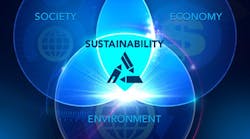In this week’s Voices of the Industry, Chris Sharp, Chief Technology Officer at Digital Realty, explores how the hybrid cloud is evolving to suit today’s high performance computing landscape.
The way enterprises consume IT services is changing, along with their expectations. The connected workforce is table stakes, and the need for ubiquitous access to high-performance business applications, with data and compute hungry requirements such as big data, neural networks, and artificial intelligence (AI), is pushing IT departments to serve as key business enablers.
Chris Sharp, CTO, Digital Realty
Therefore, an agile multi-cloud architecture has become a critical business asset. Being able to quickly and securely deploy products and services is a competitive advantage that can directly impact a business’ bottom line. Though finding comprehensive solutions that ensure critical business applications remain available, and help to simplify cloud deployment, is not easy.
As enterprise adoption has increased, the hybrid cloud solution has evolved to meet today’s transformational requirements across multiple lines of business. For best results, the environments comprising the hybrid cloud solution should be seamlessly interconnected. The difficulty of establishing that seamless connection has been part of the major challenge in the adoption of hybrid and multi-cloud computing.
So what’s changed in hybrid cloud?
The good news is that the components used to create a well-designed hybrid cloud environment are different now, and better for enabling high performance.
The Rise of Cloud
While most public cloud provider solutions started with standard computing models in which a provider offered shared resources, such as applications and storage, to the general public mostly over the Internet – now their products have evolved to much more complex business applications like big data and business analytics. New technology, such as neural networks and AI, are the hot topic right now, with cloud providers working to outdo each other in innovating new services.
This means that offerings between cloud providers can, and often do vary widely. Prices are subject to change, and outages – unfortunately – are a fact of life.
[clickToTweet tweet=”Chris Sharp: The hybrid cloud solution has evolved to meet today’s requirements across multiple lines of business.” quote=”Chris Sharp: The hybrid cloud solution has evolved to meet today’s transformational requirements across multiple lines of business.”]
The end result to the enterprise is that no single cloud solution, or even provider, is as capable as leveraging multiple solutions from multiple cloud providers. We call this multi-cloud, or hybrid-multi-cloud.
Because of this situation, many companies built their hybrid cloud environment using a combination of three component types: private compute infrastructure, public compute services, and network connectivity – which is often public internet. However, relying on public internet – especially the same public Internet that’s being used for web browsing, emails, and probably some streaming media – to access cloud compute services can limit the entire solution.
Some have since learned that’s much like sharing an Internet connection with a family of five and a couple of neighbors you don’t even know. The connection can be often unreliable, slow due to congestion, and not very secure.
The Evolution of Hybrid Cloud is here
Todays’ well-designed hybrid multi-cloud environment uses your private infrastructure, along with a secure, private network delivering connectivity between enterprises, cloud resources, and relevant networks, to deliver one efficient solution.
[clickToTweet tweet=”Chris Sharp: Hybrid multi-cloud architecture offers scalability and cost effectiveness. ” quote=”Chris Sharp: Hybrid multi-cloud architecture offers scalability and cost effectiveness. “]
Using private access dedicated to your organization, a well-designed hybrid multi-cloud architecture offers scalability and cost effectiveness by making the most of elastic cloud computing. This means enterprises can dynamically add, expand, or scale applications from multiple IT environments into a choice of service providers as needed, without incurring high upfront costs or being locked into complex, long-term contracts.
Service Exchange in our Connected Campus
The recent addition of Service Exchange to our Connected Campus further enables the optimum hybrid multi-cloud strategy by offering you a solution built for growth. By bringing all the critical data center capabilities in scale, collocation, and networking into a single, secure environment, our Connected Campus enables you to harness the power of proximity by enabling you to deploy alongside the essential computing resources that support your business.
Our Service Exchange, which delivers Connectivity-as-a-Service, offers the scalability and flexibility required by IT departments to deploy efficient and cost-effective elastic hybrid multi-cloud architectures. Additionally, Service Exchange customers can dynamically access high-performance cloud services quickly and reliably from leading providers through our self-service portal. Best of all, it also gives you control of your bandwidth, so you can self-provision to meet peak demands and unforeseen bursts, or adjust during slow times so you’re no longer paying for something you don’t need.
Whether you’re enabling online financial transactions or interactive gaming, streaming video or broadcasting medical images, a low-latency, high-performance network is critical to ensuring you and your customers can access information quickly and on short notice.
Chris Sharp is Chief Technology Officer at Digital Realty.



